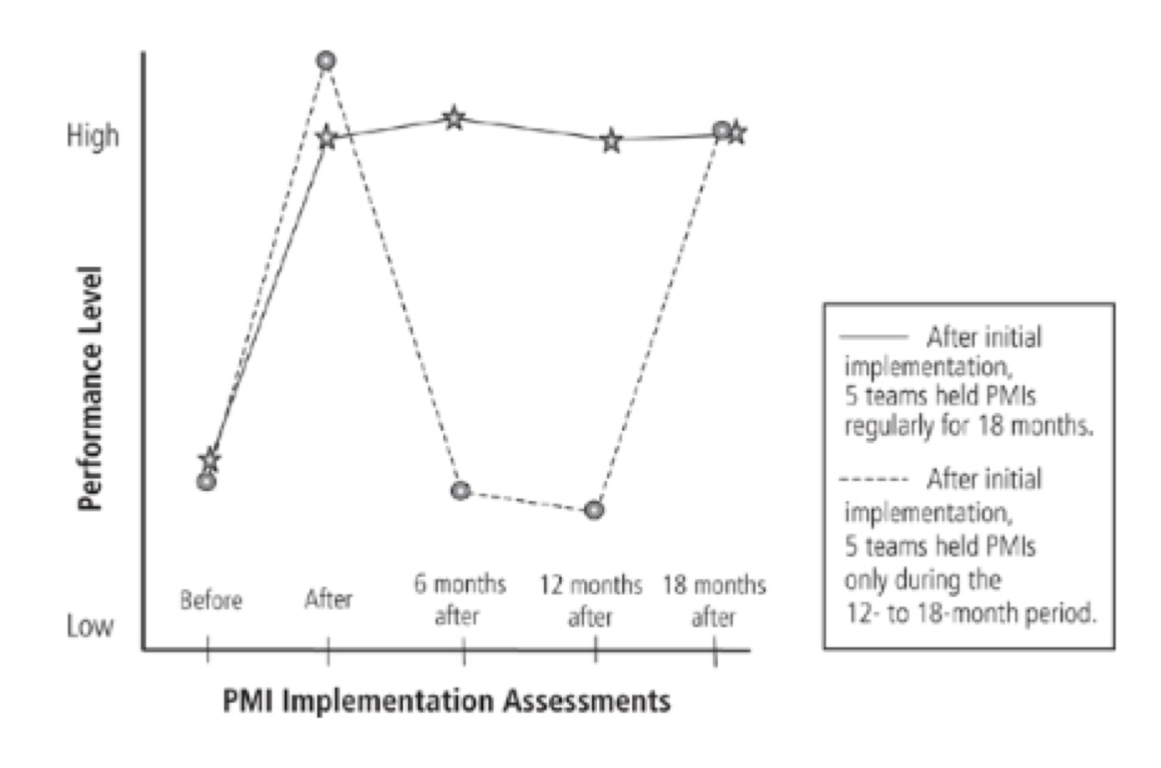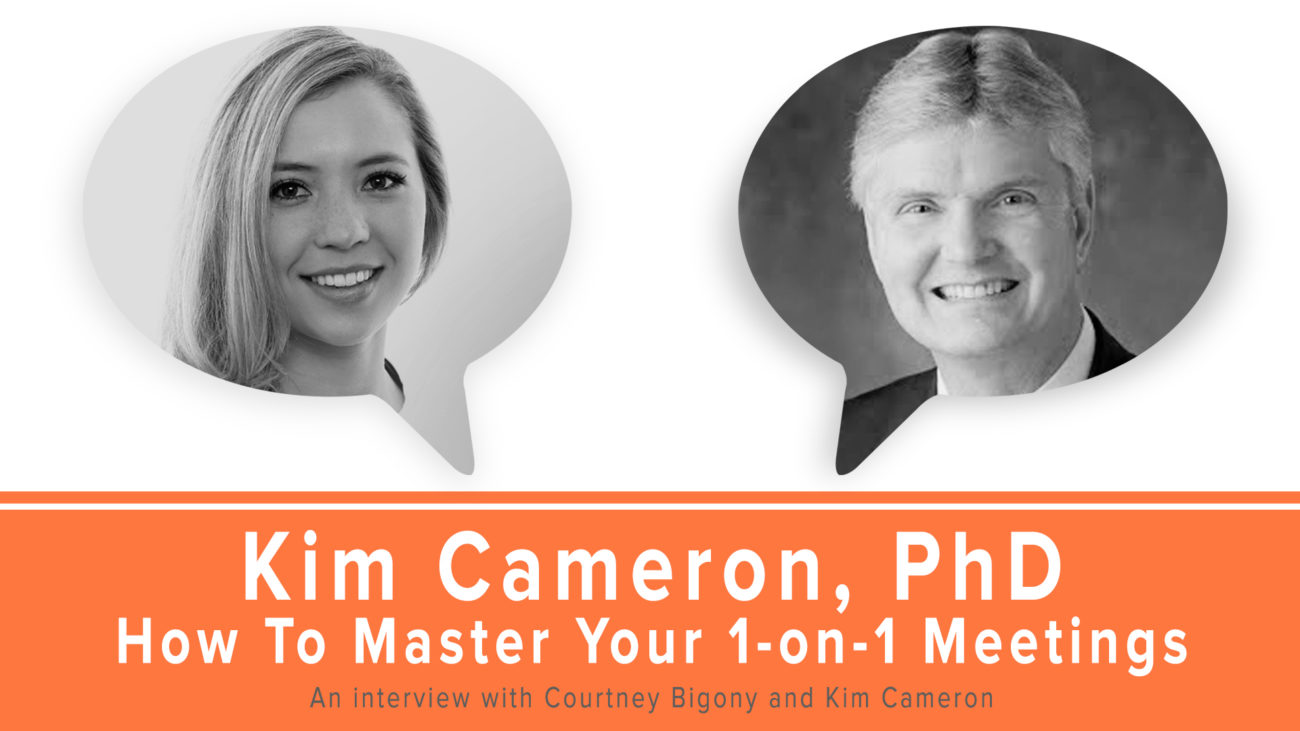Kim Cameron, Ph.D. On Mastering Your 1-on-1 Meetings
What separates high performing organizations from all the rest? Research shows that quality 1-on-1 meetings —those indispensable conversations between managers and employees— are a huge factor! One-on-ones can range from dreaded, “check-the-box” status updates to energizing, even life-changing conversations. As we’ll see below, science shows the best conversations have several things in common.
Welcome back to Talk Nerdy To Me, 15Five’s academic blog series where we get nerdy, talk to the world’s best thinkers, and break down the latest academic research that you can apply to your workplace. This time around, I spoke with Kim Cameron, Ph.D., Professor of Management and Organizations at the University of Michigan’s Ross School of Business, to explore the science behind highly effective one-on-one conversations. We dive into those critical, yet commonly overlooked practices that have a massive positive impact on both individuals and organizations.
Highlights include:
• Critical topics to address in the first one-on-one that will set all following conversations up for success
• Must have talking points to guide all recurring one-one-one conversations
• The business impact of highly effective 1-on-1 meetings
• The importance of positive energy for life-changing conversations
This conversation has been edited and condensed. To listen to the full conversation, click the video below.
Courtney: Let’s start by talking about Positive Organizational Scholarship, which is an incredible and relatively new research domain that expands what we know about the science of thriving workplaces. What makes Positive Organizational Scholarship unique and why should all leaders and HR teams be paying attention to it?
Kim: Positive Organizational Scholarship (POS for short) was introduced as a new field of study in 2002 at the University of Michigan and focuses on how to cultivate extraordinary individual and organizational performance. We study what elevates and inspires individuals and organizations rather than what is challenging or broken in an organizational setting.
In relation to fitness, it’s akin to studying Olympic level health. We work to understand the best of the human condition, specifically in the world of work. POS has an empirical base, meaning it’s backed by science and driven by hard-nosed research. The work we do also has a practical utility, so it can be applied in an actual work setting.
Courtney: That’s amazing. So POS expands what we know about workplaces that have both high performance and high employee engagement. In other words, there can be a positive sum game between employees and organizations.
Kim: Yes, and POS is not just limited to making employees happy. When you implement positive practices and when positive leadership characterizes leaders throughout the organization, there is a significant improvement in employee productivity and profitability as well. The business impact is overwhelmingly clear. In fact, positive practices even impact stock price. In one study of 40 financial service organizations, we could account for almost half their financial performance based on whether or not they’re improving in positive practices and positive leadership.
Courtney: One domain of POS is Positive Leadership. In your book on positive leaders, you talk about the importance of recurring 1-on-1 meetings between managers and employees as a key practice to help companies achieve extraordinary performance. What does the research show about effective one-on-ones?
Kim: In the research, we refer to one-on-ones as the Personal Management Interview process, or PMI for short. Highly effective one-on-ones have two parts: a one-time role negotiation session and, following that, recurring 1-on-1 meetings.
A role negotiation session is critical. It’s a one-time only meeting between a manager and each of his or her direct reports that occurs at the beginning of the relationship or right when a person enters a role. The primary purpose is to create a psychological contract. Yes, there are job descriptions and formal contracts that we all sign, but they hardly ever outline several really important aspects of the job. The goal is to create as much clarity as possible about what’s expected of one another, including three key topics:
1. Role performance and areas of responsibility. Here, the goal is to get as clear as possible about what the actual job entails. What is expected? How can I exceed expectations? What’s below expectations? What are my key areas of responsibility? What’s outside my areas of responsibility? For what am I accountable? Who is impacted by what I do?
2. Accountability and rewards. Here, the goal is to clarify accountability and to get as clear as possible about non-financial and financial rewards, especially growth and development expectations. How can I grow and expand? How can I become more capable and competent? What can I expect in terms of monetary and non-monetary rewards? What can I do that causes me to progress or move up? If I don’t move hierarchically, are there still options for growth and expanding my capabilities and talents?
3. Interpersonal relationships, mission, goals, values. What are the mission, goals, values, and culture of the organization? Am I allowed flexible working hours? What company values or norms are non-negotiable? For example, at my institution (University of Michigan), some non-negotiables include not stealing ideas without giving credit, mistreating colleagues, and so forth.
These types of things are rarely written down but need to be made clear.
At the end of the role negotiation session, you want the direct report to walk out saying, “I’m clear about my role, how I can grow and develop, how I can expand my capabilities and talents, what the organization expects of me, what I expect of the organization, and how I can best contribute.”
That’s the first step in the PMI process. It’s not about sending folks off to an HR orientation session, and it’s not in the employee handbook. This is a different kind of meeting that requires an in-person conversation and usually lasts at least one hour.
Courtney: So, according to research, for 1-on-1 meetings to be effective, this first role negotiation step must take place to create a psychological contract. Role clarity is key. This reminds me of Harvard professor, Amy Edmondson’s research showing how role clarity leads to psychological safety, which is a key factor of high performing teams.
Kim: This is a great insight. Part of the outcome of having this first meeting is to talk about things that aren’t usually written down. When I clarify all that information and when I make sure people know I have their best interest at heart, psychological safety emerges. In order to create an environment for personal growth, you need to create an environment of safety first, and that requires clarity. Safety occurs when people feel comfortable that they’re not going to be surprised.
Courtney: After this psychological contract is created, what’s next?
Kim: The one-time role negotiation meeting is followed by an ongoing, regularly scheduled meeting between a manager and each of his or her direct reports. This meeting is not an annual appraisal. It’s not a quarterly meeting. It’s not a staff meeting at the end of the week. It’s a one-on-one, eyeball-to-eyeball, knee-to-knee, private meeting that occurs at least once a month, if not more frequently.
The one-on-one is also highly collaborative. Both people prepare agenda items in advanced. The meeting can last between 45 minutes to an hour (if held only once a month). It should also be private and confidential to ensure trust and a rich experience.
Courtney: What are the major goals of recurring 1-on-1 meetings?
Kim: The number one goal is continuous improvement. If something doesn’t get better because you’ve held this meeting, don’t hold the meeting. There needs to be action. The needle has to move. Something needs to improve in order for the meeting be worth your time.
The second goal is personal development. When a manager holds regular one-on-ones they’re essentially saying, “I’m here to help. Let me help you develop and grow. And let’s collaborate to help the organization flourish.”
The third goal is feedback. One-on-ones are an opportunity to give and receive feedback. Research shows it’s important to give more positive feedback than constructive feedback, although both are important. It’s also important that managers explicitly ask for feedback.
Courtney: According to the research, what key topics should be covered?
Kim: The first item on the agenda is to follow up on the action items from the previous meeting. This ensures accountability for improvement. It’s also important to review short and long-term goals, objectives and targets, and outline what needs to be accomplished at an organizational and individual level. Managers can share key pieces of information and provide important context.
It’s also a time to give and receive feedback, including praise for what’s going well. Managers and employees address any roadblocks or obstacles that are getting in the way of performance. Nobody should fail because they can’t get what they need, so it’s an opportunity to identify resource needs. It’s also an opportunity for training and development and to help people achieve their career aspirations.
In addition, 1-on-1 meetings should be held in a safe space to address and handle interpersonal issues, which are almost universal. Handle those before they turn into explosions. Employees can also bring up important personal issues that may or may not be affecting their work. At the end of the meeting, make a list of action items to complete before the next one-on-one.
Courtney: What’s the business impact of one-on-ones that include both parts: the one-time role negotiation session and recurring check-ins with the key pieces you highlighted?
Kim: Evidence shows recurring one-on-ones pay off. When organizations implement highly effective one-on-ones, performance, productivity, customer satisfaction, and employee engagement significantly improve.
In one study (see graph below), organizations implemented the two-part one-on-one process with an initial role negotiation meeting and recurring check-in meetings. Over time, performance went up. But then they stopped because people said, “Whoa, wait a minute. I don’t have time for this. You’re superimposing on my schedule a one-hour meeting with every direct report, which is normally four to eight people. I don’t have an extra four to eight hours a month for this.”
So several organizations stopped. Then we continued to measure their performance. 18 months later, the organizations that stopped saw a huge deterioration in performance. So they implemented recurring one-on-ones again company-wide, and performance went back up.

Source: Positive Leadership, Strategies for Extraordinary Performance by Kim Cameron, Wayne Boss, 1983
Courtney: To close, let’s talk about positive energizers. What are positive energizers and how can positive energy transform the one-on-one conversation?
Kim: I’m so glad we’re addressing this. Let’s first unpack the word energy. There are several kinds of energy. The first is called physical energy, and when I use, it it diminishes. For example, if I ran a marathon, I’d need recuperation time. Emotional energy is similar. When I use it, it diminishes. For example, if I get into an argument, I need to recoup and recover. Mental energy is the same, which is why in school we have semester breaks and at work, vacation time. The fourth kind of energy is called relational energy. It’s the only kind of energy that when you use it, it elevates.
Relational energy occurs between two people, and more is better. Some interactions with people are positive, life-giving experiences while other interactions can feel like an energy suck. Positive energizers create support and vitality in others, they make everybody else better, and they make people feel that they matter.
Positive energizers aren’t limited to leadership positions, and they’re not necessarily the folks at the top. Everybody can be a positive energizer, and the more energizers there are, the better the performance in an organization. Research shows the highest performing organizations have 3x more positive energizers than average organizations!
Courtney: Wow. So, in 1-on-1 meetings, relational energy is key.
Kim: Yes. You see, there’s nothing magic about the one-on-one if it’s just checking off a list of agenda items. But one-on-ones can be magic, even life-changing, especially those that create a stable foundation of clarity and psychological safety, actively unlock people’s highest potential, and beam with positive energy.
Kim Cameron is Professor of Management & Organizations at University of Michigan’s Ross School of Business. His past research includes organizational virtuousness, downsizing, effectiveness, quality culture, and leadership excellence. Kim is also co-founder and core faculty at the Center for Positive Organizations, a world-renowned research center on Positive Organizational Scholarship, whose mission is to inspire and enable leaders to build high-performing organizations that bring out the best in people.
is Professor of Management & Organizations at University of Michigan’s Ross School of Business. His past research includes organizational virtuousness, downsizing, effectiveness, quality culture, and leadership excellence. Kim is also co-founder and core faculty at the Center for Positive Organizations, a world-renowned research center on Positive Organizational Scholarship, whose mission is to inspire and enable leaders to build high-performing organizations that bring out the best in people.
 Courtney Bigony is Director of People Science at 15Five, continuous performance management software that includes weekly check-ins, objectives (OKR) tracking, peer recognition, 1-on-1s, and reviews. She is also the founder of The Deep Feedback Movement, where she provides actionable insights for People Teams based on the latest social science research, and a Fellow at the Center for Evidence Based Management.
Courtney Bigony is Director of People Science at 15Five, continuous performance management software that includes weekly check-ins, objectives (OKR) tracking, peer recognition, 1-on-1s, and reviews. She is also the founder of The Deep Feedback Movement, where she provides actionable insights for People Teams based on the latest social science research, and a Fellow at the Center for Evidence Based Management.




